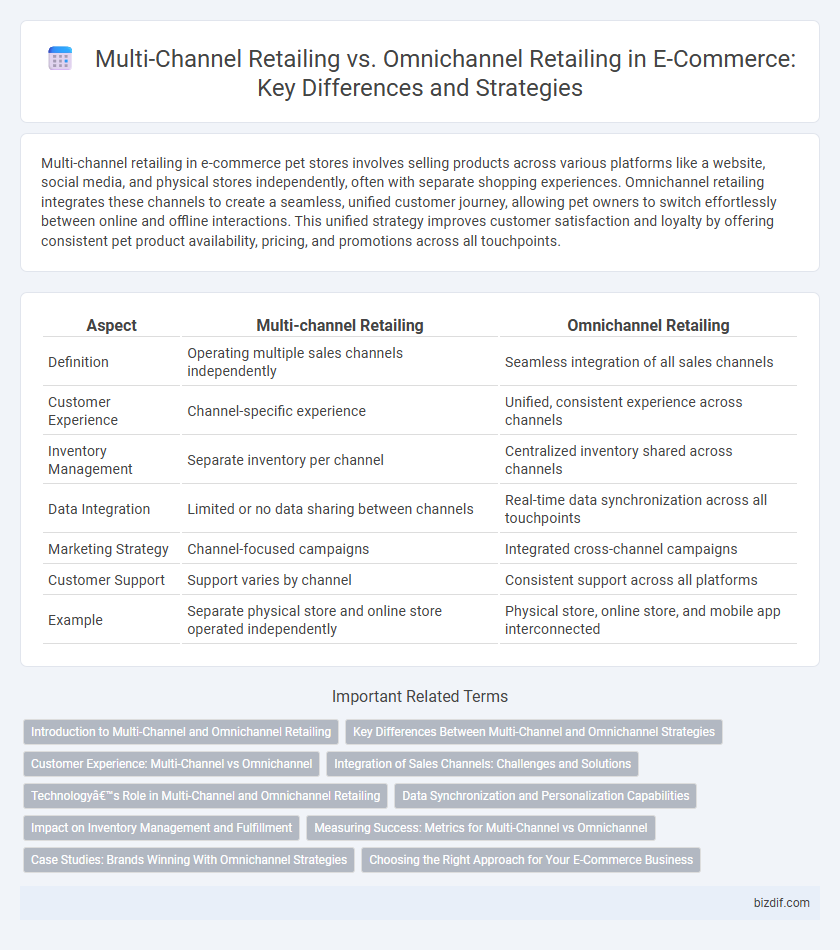Multi-channel retailing in e-commerce pet stores involves selling products across various platforms like a website, social media, and physical stores independently, often with separate shopping experiences. Omnichannel retailing integrates these channels to create a seamless, unified customer journey, allowing pet owners to switch effortlessly between online and offline interactions. This unified strategy improves customer satisfaction and loyalty by offering consistent pet product availability, pricing, and promotions across all touchpoints.
Table of Comparison
| Aspect | Multi-channel Retailing | Omnichannel Retailing |
|---|---|---|
| Definition | Operating multiple sales channels independently | Seamless integration of all sales channels |
| Customer Experience | Channel-specific experience | Unified, consistent experience across channels |
| Inventory Management | Separate inventory per channel | Centralized inventory shared across channels |
| Data Integration | Limited or no data sharing between channels | Real-time data synchronization across all touchpoints |
| Marketing Strategy | Channel-focused campaigns | Integrated cross-channel campaigns |
| Customer Support | Support varies by channel | Consistent support across all platforms |
| Example | Separate physical store and online store operated independently | Physical store, online store, and mobile app interconnected |
Introduction to Multi-Channel and Omnichannel Retailing
Multi-channel retailing involves selling products through multiple, distinct channels such as online stores, physical locations, and social media platforms, each operating independently. Omnichannel retailing integrates these channels to create a seamless, unified shopping experience, allowing customers to switch between platforms effortlessly. Businesses adopting omnichannel strategies often see increased customer loyalty and higher sales by providing personalized interactions across all touchpoints.
Key Differences Between Multi-Channel and Omnichannel Strategies
Multi-channel retailing involves selling products through various independent channels such as physical stores, online websites, and social media platforms, each operating separately without integration. Omnichannel retailing creates a seamless customer experience by integrating all channels, allowing customers to switch between touchpoints while maintaining consistent interactions and personalized service. Key differences include the level of channel integration, customer experience continuity, and data synchronization across platforms.
Customer Experience: Multi-Channel vs Omnichannel
Multi-channel retailing offers customers multiple purchasing paths such as online stores, physical locations, and mobile apps, but these channels often operate independently, leading to inconsistent user experiences. Omnichannel retailing integrates all sales channels into a seamless, unified platform, allowing customers to switch effortlessly between online and offline touchpoints while maintaining personalized engagement and consistent service. This holistic approach enhances customer satisfaction, loyalty, and lifetime value by providing a coherent and convenient shopping journey across all channels.
Integration of Sales Channels: Challenges and Solutions
Integration of sales channels in multi-channel retailing often faces challenges such as inconsistent customer experiences and fragmented inventory management. Omnichannel retailing offers solutions by unifying data across platforms, enabling real-time inventory visibility and seamless customer interactions. Leveraging technologies like cloud-based ERP systems and centralized CRM tools enhances synchronization, reduces operational silos, and improves overall efficiency.
Technology’s Role in Multi-Channel and Omnichannel Retailing
Advanced technology integration drives seamless customer experiences in omnichannel retailing by unifying inventory management, customer data, and sales platforms across all channels. Multi-channel retailing relies on distinct, often siloed technologies for each sales channel, which can limit consistent customer engagement and operational efficiency. Utilizing AI-powered analytics and cloud-based systems enhances real-time decision-making and personalized marketing across both multi-channel and omnichannel frameworks.
Data Synchronization and Personalization Capabilities
Multi-channel retailing involves managing separate sales channels with limited data synchronization, often resulting in fragmented customer experiences and inconsistent personalization. Omnichannel retailing integrates data across all channels, enabling seamless synchronization that supports real-time inventory updates, unified customer profiles, and personalized marketing strategies tailored to individual behavior. Enhanced data integration in omnichannel systems drives higher customer engagement and improved conversion rates through consistent, personalized interactions across web, mobile, and in-store platforms.
Impact on Inventory Management and Fulfillment
Multi-channel retailing disperses inventory across separate channels, often leading to increased safety stock and challenges in real-time inventory visibility, which can hinder fulfillment efficiency. Omnichannel retailing integrates inventory management systems across all channels, enabling centralized stock control, reducing overstock, and supporting seamless order fulfillment from multiple locations. This integration enhances demand forecasting accuracy and accelerates delivery times, improving overall customer satisfaction and operational efficiency.
Measuring Success: Metrics for Multi-Channel vs Omnichannel
Measuring success in multi-channel retailing often focuses on isolated metrics such as channel-specific sales, customer acquisition cost, and individual conversion rates. In contrast, omnichannel retailing emphasizes integrated metrics including overall customer lifetime value, seamless cross-channel engagement rates, and unified customer satisfaction scores. Tracking these holistic omnichannel KPIs provides deeper insights into customer behavior and business performance across interconnected retail touchpoints.
Case Studies: Brands Winning With Omnichannel Strategies
Brands like Nike and Sephora demonstrate how omnichannel retailing drives higher customer engagement and sales by integrating physical stores, mobile apps, and online platforms seamlessly. Case studies reveal that omnichannel approaches provide personalized experiences, real-time inventory updates, and unified loyalty programs, leading to increased customer retention compared to traditional multi-channel retailing. These success stories highlight how leveraging data analytics and consistent brand messaging across all touchpoints boosts overall revenue and brand loyalty.
Choosing the Right Approach for Your E-Commerce Business
Multi-channel retailing allows e-commerce businesses to sell on various platforms independently, maximizing reach through multiple sales channels like online marketplaces, social media, and physical stores. Omnichannel retailing integrates these platforms to create a seamless customer experience by unifying inventory, order management, and customer data across all touchpoints. Selecting the right approach depends on your business complexity, customer experience goals, and resources for system integration and data synchronization.
Multi-channel Retailing vs Omnichannel Retailing Infographic

 bizdif.com
bizdif.com